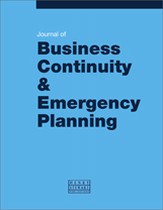The hexagon hypothesis: Six disruptive scenarios
Abstract
This paper aims to bring a simple but effective and comprehensive approach to the development, delivery and monitoring of business continuity solutions. To ensure that the arguments and principles apply across the board, the paper sticks to basic underlying concepts rather than sophisticated interpretations. First, the paper explores what exactly people are defending themselves against. Secondly, the paper looks at how defences should be set up. Disruptive events tend to unfold in phases, each of which invites a particular style of protection, ranging from risk management through to business continuity to insurance cover. Their impact upon any business operation will fall into one of six basic scenarios. The hexagon hypothesis suggests that everyone should be prepared to deal with each of these six disruptive scenarios and it provides them with a useful benchmark for business continuity.
The full article is available to subscribers to the journal.
Citation
Burtles, Jim (2015, September 1). The hexagon hypothesis: Six disruptive scenarios. In the Journal of Business Continuity & Emergency Planning, Volume 9, Issue 1. https://doi.org/10.69554/XPPJ9202.Publications LLP
